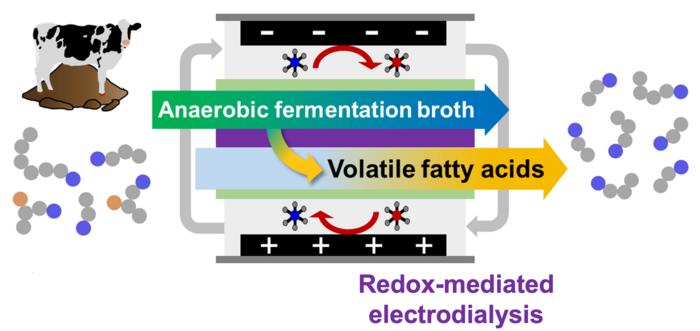A groundbreaking study emerging from the University of Illinois Urbana-Champaign highlights an innovative fusion of chemical engineering and animal science, leading to a transformative method for recovering valuable industrial chemicals from animal waste. This research represents a significant leap towards achieving circular economy principles, showcasing environmental sustainability and resource efficiency in today’s agricultural practices. The focus of this exploration centers on volatile fatty acids (VFAs), which are essential organic molecules used in various industries, including cosmetics, plastics, and food additives.
The newly developed nanofiltration system targets the extraction and separation of VFAs from cattle manure that has undergone anaerobic digestion in bioreactors. By leveraging redox-mediated electrodialysis, this system stands out for its remarkable 80% increase in energy efficiency compared to conventional electrochemical processes. The research team’s progress signals a potential paradigm shift in how industries can transition from traditional petrochemical feedstocks to more sustainable biowaste-derived resources.
At the heart of this discovery lies a combination of selective ion-exchange membranes and advanced electrochemical separation techniques. Traditional methods of VFA extraction often result in significant energy expenditures and environmental waste; however, the novel approach developed in this study drastically minimizes these drawbacks. By employing electrical fields to manipulate charged chemical species, combined with redox molecules that can dynamically alter their electrical structures, the research team has tackled one of the foremost challenges in environmental science: how to efficiently extract organic chemicals from chemically complex mixtures.
The researchers, led by Professor Xiao Su, list multiple benefits of their system. “It’s incredible that we’re able to obtain industrial chemicals like VFAs from something like manure,” Su noted, underlining the intersection of waste management and chemical production efficiency. This technology not only promises to reduce waste but also paves the way for the reprocessing of byproducts into valuable resources, thereby transforming the waste-to-energy landscape.
By using redox-mediated electrodialysis, the researchers have developed membranes with unique properties that allow for the precise differentiation of chemically diverse VFAs, optimizing the separation process. The uniqueness of this technique lies in its ability to isolate specific VFAs based on their molecular structures, thus maximizing yield and purity while minimizing energy consumption. This specificity is critical, as the market for VFAs is poised to grow, driven by increasing demand for biodegradable alternatives and sustainable raw materials.
With the collaboration of animal sciences professor Roderick Ian Mackie, the team fermented a broth from cattle manure, and applied their innovative separation technique to extract shorter-chain VFAs, effectively isolating key resources from a multitude of longer-chain VFAs and other compounds present in the mixture. “This is an innovative approach to utilizing waste material from concentrated animal production facilities, which contribute to environmental pollution, and converting it into valuable industrial chemicals,” Mackie explained, emphasizing the dual benefit of pollution reduction and resource recovery.
In addition to the advancements in VFA recovery, this research addresses significant concerns about the environmental impacts associated with intensive animal farming. Conventional practices often lead to large-scale waste generation, which poses risks of groundwater contamination and air pollution. By effectively processing manure and creating valuable industrial outputs, this technology not only contributes to cleaner production methods but also reinforces the ethical utilization of agricultural resources.
The implications of this technology reach far beyond the laboratory and could revolutionize how industries source their chemical inputs. The scalability of this system appears promising, with future plans to adapt the technology for industrial applications. This could potentially transform waste management practices across various agricultural sectors, facilitating a more sustainable cycle of production and consumption.
The National Academy of Sciences and several other institutions have recognized the study’s contributions to sustainable engineering. The research was featured on the inside front cover of the February 5, 2025 issue of the journal Advanced Functional Materials, signifying its importance within the scientific community. Such recognition illustrates the scholar’s commitment to pushing boundaries in both engineering and environmental sustainability, which could inspire future research initiatives worldwide.
As the research team considers the next steps, plans for detailed materials design and further membrane development are prioritized. “If we can make the membranes even more selective than they already are, we can decrease the overall cost and energy expenditure for the process,” Su stated, effectively summarizing the ambitions that lie ahead. Advances like these not only hold practical implications for industry but also bolster academic inquiries into sustainable practices.
Overall, this innovative research signifies a remarkable stride towards addressing global challenges in sustainability and resource management. By adeptly transforming waste into valuable chemicals, the work at the University of Illinois Urbana-Champaign stands as a compelling model for future explorations in both the environmental and chemical engineering domains. The venture represents a pivotal moment where science and sustainability converge, offering hope for a greener, more resource-efficient future.
As society continues to grapple with the pressing challenges of climate change and environmental degradation, research endeavors like this shine a light on potential solutions. By converting waste into resources through advanced technologies, the groundwork is laid for a future where cyclic resource use becomes the norm, rather than the exception. This approach could inspire further innovations, elevating environmental consciousness across multiple sectors and fostering a more sustainable global economy.
The journey toward circularity and sustainable practices requires a concerted effort from researchers, industries, policymakers, and consumers alike. As highlighted by this research, the potential for collaborative innovation in the field of waste management is ripe for exploration. The momentum generated by this study could be the catalyst that inspires a wave of transformative practices across agriculture, manufacturing, and beyond.
Subject of Research: Recovery of volative fatty acids from animal waste
Article Title: Controlling Bicontinuous Polyelectrolyte Complexation for Membrane Selectivity: Redox-Mediated Electrochemical Separation of Volatile Fatty Acids
News Publication Date: March 26, 2025
Web References: N/A
References: N/A
Image Credits: The Grainger College of Engineering at the University of Illinois Urbana-Champaign
Keywords: Volatile fatty acids, biowaste, anaerobic digestion, electrochemical separation, circular economy, environmental sustainability, nanofiltration system, ion-exchange membranes, redox-mediated electrodialysis, chemical engineering, animal sciences, resource recovery.




